
Background information
Five weeks until my half marathon – optimising my diet
by Siri Schubert

The idea is born. But what next? In six months’ time, we, Oliver Fischer and Claudio Candinas, want to complete a half marathon at the Greifensee Run. As a first step, we want to understand where our bodies are at. That’s why we signed up up for a fitness, performance and metabolic analysis.
I’m stretched out on the sofa in my home office space aka guest room aka entertainment room. With a Blackroll under my left calf, I’m gently trying to relax the cramped muscle. There’s a pair of crutches on the floor next to me. Luckily, I still had them in the cellar from a knee operation many years ago. For a few days now, I’ve been hobbling around the apartment in slo-mo enduring constant pain in both calf muscles. Believe me, I worked hard for that cramp and the overstretched muscle. They’re both remnants of the fitness check I underwent. Without my crutches I’m incapable of getting from the office chair to the couch, the bar stool to the coffee machine or the toilet to the sink. Frustratingly, I should actually be preparing for a half marathon.
But let’s rewind.
I’ll spare you the Insta motivational quotes, but declare «Nothing will work unless you do» an exception. Oh, and it’s also our motto. And so, we, Claudio Candinas and I, got to work. The first task? Undergoing a comprehensive fitness, performance and metabolic analysis to find out how our bodies are made up, how we burn energy and what our muscular base is like at the start of our six-month half marathon project.
To do this, we used the services provided by the experts at Medathletik.
It’ll be the only time during our challenge that professionals give us at least a few pointers on how realistic our plan is and where we should start. We won’t be given any diet or training plans, and will only meet them again at the very end of our challenge to see which changes we’ve implemented in the past six months.
What we had tested:
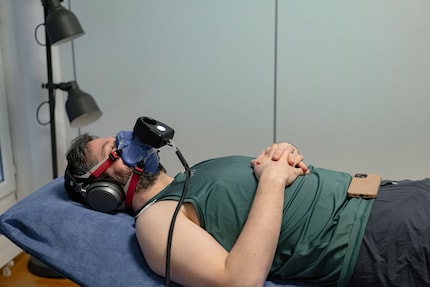
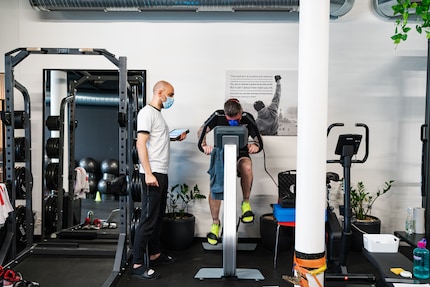
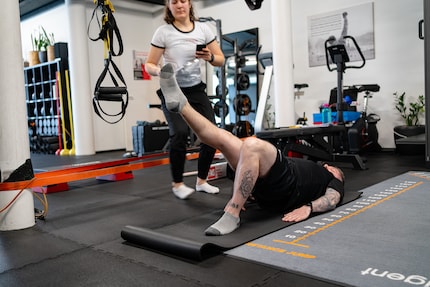
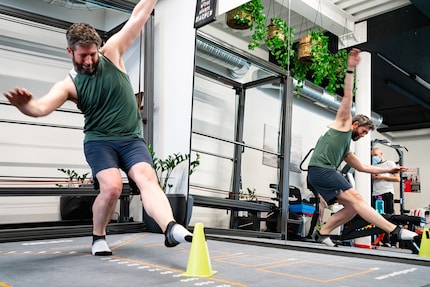
Are you curious about performance diagnostics and nutrition in connection with exercise? For further info, check out Siri Schubert’s articles on the subject:
First up, I’d like to set a few things straight. My ID’s lying and my scales are plain mean. How dare my ID card tell me I’m 173 centimetres tall when I’m actually 3 centimetres taller?! I can’t believe the passport office let it get away with these lies. But the cheek of the ID card’s
outdone by my scales. They mercilessly confront me with the brutal reality and an unforgiving display: 82.9 kilos and a body fat percentage of roughly 30 per cent. Bit harsh, scales! In other words, I’m one-third fat. A human chip, so to speak. I doubt I have what it takes to complete a half marathon at this fighting weight.
However, I’m trying to turn frustration into motivation for our project and am looking forward to seeing the results of my metabolism and performance analysis. And lo and behold, my body gets 47 per cent of its energy from fat, so almost half. Turns out, I’ve plenty of weight to shed, which is great. All I have to do now is exercise in the right heart rate range to burn off that fat. Ideally, this is at 115 beats per minute. In other words, a high-energy stroll is what I should be aiming for to melt away those kilos fast. Sounds easy, but also kind of insulting.
The performance tests at Medathletik were anything but a walk in the park. I was bending, stretching, contorting and mainly exerting myself in slow motion. Yup, the exercises – especially those for the core muscles – were tough. I can still feel the after-effects three days later. But this also means that something’s happening in my body. And that’s a great feeling.
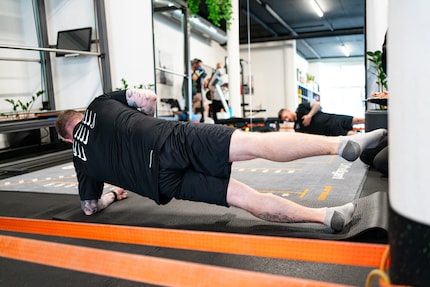
I’m now deep diving into all the results of the analyses and trying to put together a workout plan and, above all, a nutrition plan I can easily integrate into my everyday life. Most importantly, it should be one I won’t get sick of two weeks into starting. That’s because Oliver and I promised each other to go through with it together. Come what may. I miss my nightly trips to the fridge already.
For motivational purposes I gifted myself an Apple Watch before going on this fitness quest. I’ll have to track all my activity, after all. What’s more, I’m just a big gadget fan.
I’m just under 1.77 metres tall and weigh 84 kilogrammes. With a BMI of 26.9 and a body fat percentage of 27.7 per cent, I’m definitely carrying around a few kilos of belly fat too much. At least that’s what Medathletik’s Dimi Evangelidis, who’s carrying out the tests, tells me matter-of-factly. And I agree that losing three to four kilos would be a good idea. Seems like a doable goal if I start doing regular endurance sports.
But apparently my metabolism doesn’t agree. The analysis showed that my body apparently gets two thirds of its energy from carbs; with fat accounting for just under 20 per cent of the energy used. Great. So first, I have to teach my muscles how to get their energy from my generous fat stores.
Thanks to the spiroergometry results, I now know at what heart rate I need to cycle or jog for the best fat-burning results. The good news is that this value (142 bpm) is also the range in which I train my basic aerobic endurance most efficiently (134–150 bpm). If I’ve understood correctly, I need to lay this foundation first in order to have a chance of running 21 kilometres in September.
Sounds like we have a win-win situation.
At least in theory. As I mentioned above, I can only dream of jogging at the moment. I can’t even take two steps through my home office without a walking aid.
And the third test, the FMS, is to blame for this. Or rather one of the test’s exercises. One that involves standing on one leg on a stepper and using your calf muscles to push your body up and down – until you can’t any more. I kept it up for quite long. Especially with my left leg. It seems that any sign of pain or fatigue from my left calf just didn’t reach my brain properly. Why do I think that? Because I overworked my muscles to such an extent that I can’t take straight step – even days later.
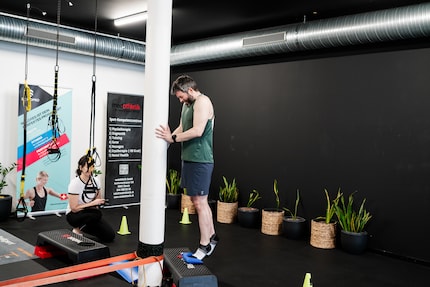
So now we’re familiar with our base fitness levels. We’ll start building on these over the next few months and then run 21.1 kilometres around the Greifensee at the end of September. We’ll now take turns giving you a bi-weekly update on our training and learning progress. And it won’t just be about running but also about food and our everyday lives. After six months, we’ll hopefully be prepared to master a half marathon with reasonable confidence. But above all, we’ll have improved our exercising and eating habits in the long term. So that we’re not back to square one or in worse shape next March.
Stay tuned.
And follow Claudio and Oliver.
Project Half Marathon – how it all started:
Globetrotter, hiker, wok world champion (not in the ice channel), word acrobat and photo enthusiast.
Interesting facts about products, behind-the-scenes looks at manufacturers and deep-dives on interesting people.
Show all
Background information
by Oliver Fischer

Background information
by Oliver Fischer

Background information
by Patrick Bardelli